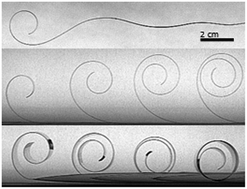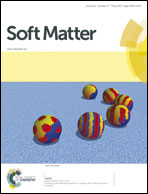Curling and rolling dynamics of naturally curved ribbons†
Abstract
When a straight rod is bent and suddenly released on one end, a burst of dispersive flexural waves propagates down the material as predicted by linear beam theories. However, we show that for ribbons with a longitudinal natural radius of curvature a0, geometrical constraints lead to strain localization which controls the dynamics. This localized region of deformation selects a specific curling deformation front which travels down the ribbon when initially flattened and released. Performing experiments on different ribbons, in air and in water, we show that initially, on length scales on the order of a0, the curling front moves as a power law of time with an exponent ranging from 0.5 to 2 for increasing values of the ribbons' width. At longer time scales, the material wraps itself at a constant speed Vr into a roll of radius R ≠ a0. The relationship between Vr and R is calculated by a balance between kinetic, elastic and gravitational energy and both internal and external powers dissipated. When gravity and drag are negligible, we observe that a0/R reaches a limiting value of 0.48 that we predict by solving the Elastica on the curled ribbon considering the centrifugal forces due to rotation. The solution we propose represents a solitary traveling curvature wave which is reminiscent to propagating instabilities in mechanics.


 Please wait while we load your content...
Please wait while we load your content...